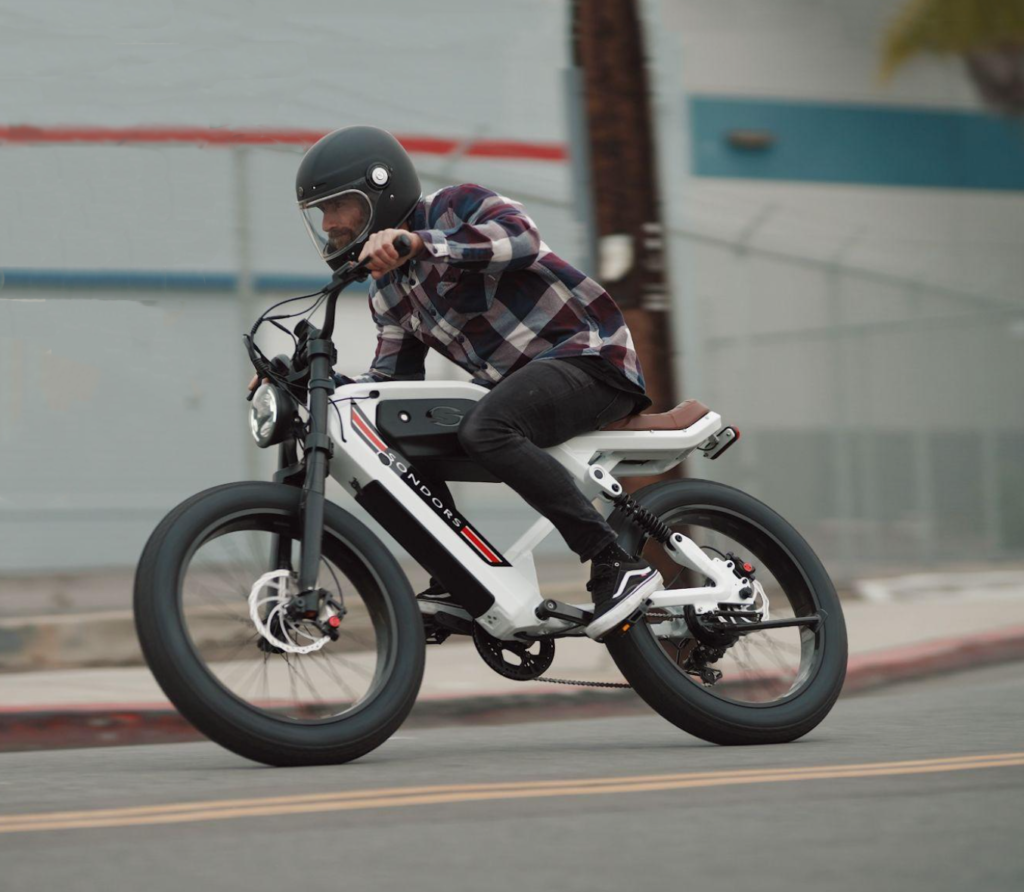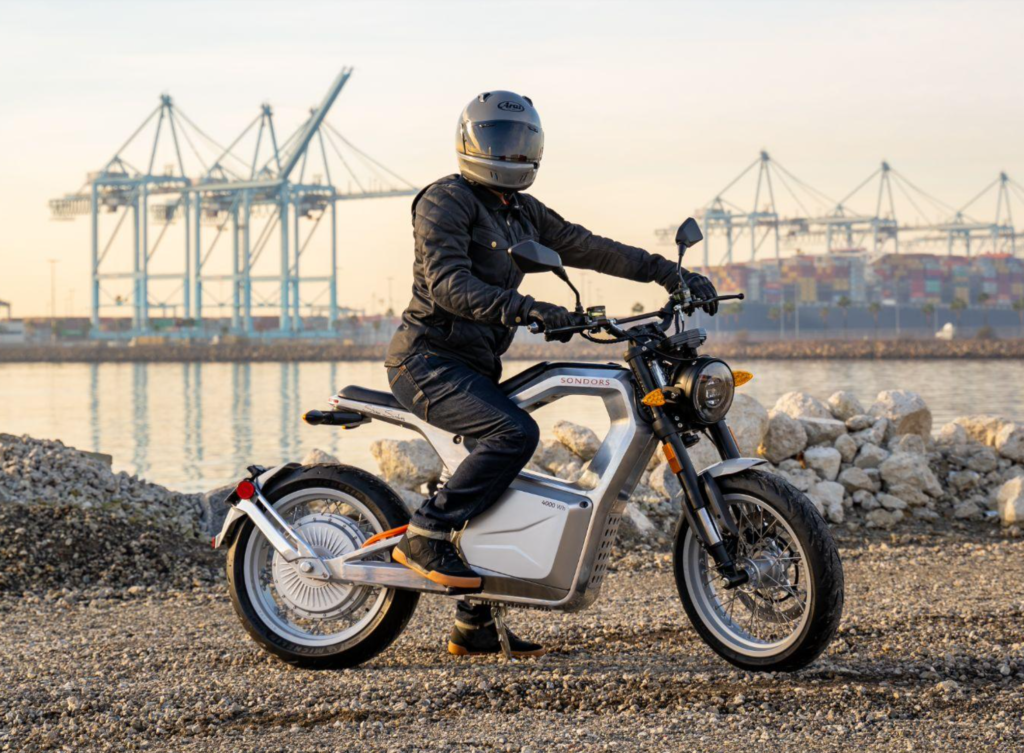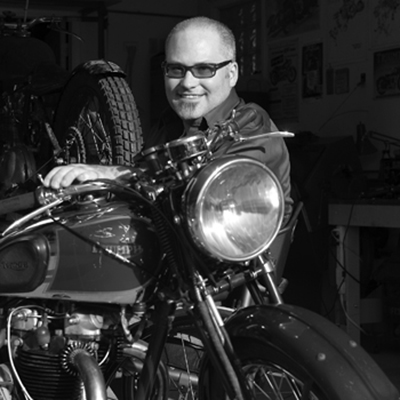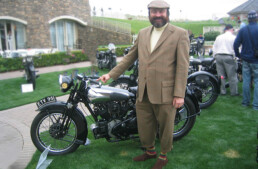Now on view at the Petersen Automotive Museum in LA is our latest moto-centric exhibit: Electric Revolutionaries. Curated and concepted by Paul d’Orléans, the exhibit focusses on 11 designers making an impact on the electric mobility scene, each in very different ways; from top speed to accessible mobility, from aesthetic perfection to hand-cobbled and crude, from luxury to mass market to one-off. Each of these designers is tackling a different set of issues, illustrating the wide-open nature of EV design at this early stage of the industry. Our 11 designers are brave pioneers, embracing what could be the future of mobility, digging in on what design features make EVs unique, and challenging our ideas of ‘what is a car or motorcycle?’
Storm Sondors, while born in Latvia, has made his fortune in the USA, first in toy manufacturing, and now in electric vehicles with his company SONDORS. His vision was to build affordable e-Bikes, and got his start via the second-most successful Indiegogo fundraiser in history, which exceeded its goal by 7000%. SONDORS is now one of the largest e-Bike manufacturers in the USA, and is distributed in 42 countries. More recently, he turned his attention to disrupting the e-Moto scene by revealing the dramatic Metacycle, with a futuristic cast-aluminum chassis and an industry-beating low price tag. Vintagent Profiles Editor Greg Williams interviewed Storm for this story, and shares the back story on the creation of SONDORS.











Related Posts
July 10, 2017
The Vintagent Selects: Why I Ride – Episode 1: Passion At Work
"The first time I felt that tire hook…



Damn ! Thought I was going to The Vintagent …. but ended up on The E-Sycophant instead . Damn ! Oh well … message received… loud and clear .
Hasta la vista . Call me when things go back to normal ’round these here parts
And err … as far as E Bicycles are concerned … get off yer fat ugly posteriors .. ride a REAL bike … and get some gorram exercise … god [ which ever one you bow down to ] knows … y’all need it … badly
😎
Well that’s an ignorant comment, no disrespect intended you’re just not aware that your standard electric bike riders get a lot more exercise than regular bike riders because the electric bike will get ridden a lot more than a regular bike a regular bike will spend most of its time hanging in the garage and electric bike will almost always be out being ridden by somebody
Thx
I’ll get back to you on the music portion of my existence SO HOW OLD ARE YOU cus the older u get the more attractive the E bike becomes so if your not over 55 just wait bucko I can’t explain it but shit starts to happen around 50 to 54 then 55 to 58 then well I’m hoping the peddle assist will keep my ass in shape and quads and the E will be sorta like taking real MDMA for the first time wow the year was 1992 in Berkeley fuck great shit anyways just thought I’d see how good a guitar slinger you are for this next year I should be starting out from South Lake Tahoe across country doing a pod cast of BUILDING A BAND from the ground up by hitting small and big cities in a Rv Or 5th wheel and do auditions looking for real tallent that doesn’t necessarily have to want to drop everything and go on tour but it would be ideal however if someone is that gifted I’m sure I’ll figure out a way to make everything work as I go forward you can face book Jake RYKEMAN and read my story though iv lost my password to that account I’ll probably create another one using my real name Kevin Brosnan or ( Nivek Nansorb my name backwards which is up )
The aforementioned Mr G-Stringer probably is one of those people who were the original marketing target for this gentleman, those who haven’t ridden a bicycle in over 20 years! And as Kevin noted once you hit 50 your entire metabolism changes. So unless you’ve been training for monthly triathlons your ass isn’t going to be in the same shape it was when you were 20! As someone who was once a professional athlete but due to the physical abuse most of us put ourselves through just to be able to be able hang onto our dreams my joints are no longer able to pedal a standard bicycle. So what do we do to help us stay active Slinger? If you’re a few years from getting to “middle age” I’m sure that you haven’t thought that far ahead. That’s pretty typical of the 20-40 generation. But just because you haven’t thought about alternatives to a “regular” physical workout regimen please don’t slam those of us who are.
I’ve had 3 Sondors ebikes and got an email from Sondors asking if I was interested in getting one of their Metacycles?
I was, so I put $100.00 down and $700.00 per month for 7 months. That was 15 months ago. My Metacycle was delivered a week ago last Saturday. IT’S THE WRONG COLOR! Definitely a 1st World Problem, but I would like the Silver one I ordered. Maybe I should have refused delivery but it had been so long I was afraid I might not get another one for another 15 months. Let’s see what happens.
Well, I’ve been trying to get the COLOR ISSUE RESOLVED to no avail. I have received one email and two phone calls from a woman (@ Sondors saying “I’ll pass on your concern about the color not being what you wanted, and someone will contact you”. It’s been two weeks since the last call and no communication. There have been a few days when I’ve ridden my SurRon but I’d like to try the METACYCLE. PLEASE CALL!
David Henry Sprong
Picked up 2 Safe step bikes but didn’t get a manual with either. Suggestions
This link has many instruction videos for your model: https://sondors.com/pages/assembly